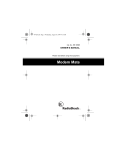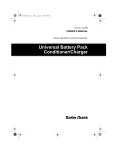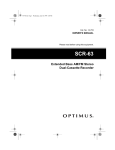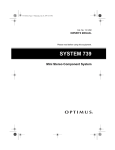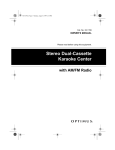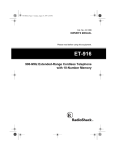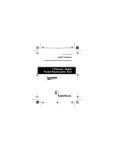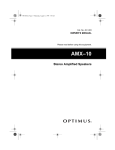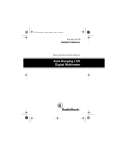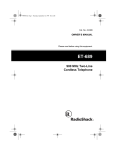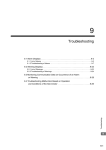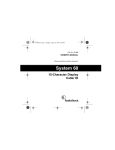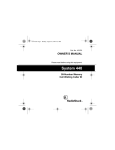Download Radio Shack SYSTEM 612 Owner`s manual
Transcript
43-462.fm Page 1 Friday, August 13, 1999 9:02 AM Cat. No. 43-462 / RSU 11666195 OWNER’S MANUAL Please read before using this equipment. Caller ID Server 43-462.fm Page 2 Friday, August 13, 1999 9:02 AM INTRODUCTION Your RadioShack Caller ID Server enhances your System 612 Speakerphone (RadioShack Cat. No. 43-461) by displaying Caller ID information on the Speakerphone. When the Caller ID Server is connected to the same telephone lines as the Speakerphone, the Speakerphone displays the caller’s phone number (and name, if available in your area) and the current date and time, as provided by your local phone company to Caller ID service subscribers. Its features include: Caller ID Memory — stores and displays up to 40 call records, including phone numbers and names. Important Information: • Your Caller ID Server is designed to work only with a System 612 Speakerphone. The Caller ID Server does not work if you connect it to any other telephone. • To use this Caller ID Server, you must be in an area where Caller ID service is available, and you must subscribe to the service. • Your Caller ID Server displays number only, or both name and number, depending on the information provided by your phone company. This Caller ID Server has been tested and found to comply with all applicable UL and FCC standards. Review Scrolling — lets you scroll through the stored list of incoming call records. Caller ID Memory Dial — lets you select a stored phone number from Caller ID memory, then dial it with the touch of a button. We recommend you record the server’s serial number here. The number is on the label on the bottom of the server. Serial Number __________________ © 1996 Tandy Corporation. All Rights Reserved. RadioShack is a trademark used by Tandy Corporation. 2 43-462.fm Page 3 Friday, August 13, 1999 9:02 AM READ THIS BEFORE INSTALLATION We have designed your Caller ID Server to conform to federal regulations, and you can connect it to most telephone lines. However, each device you connect to the phone line draws power from it. This power draw is the device’s Ringer Equivalence Number, or REN. The REN is shown on the bottom of the server. Warning: To prevent fire or shock hazard, do not expose this product to rain or moisture. CAUTION RISK OF ELECTRIC SHOCK. DO NOT OPEN. CAUTION: TO REDUCE THE RISK OF ELECTRIC SHOCK, DO NOT REMOVE COVER OR BACK. NO USER-SERVICEABLE PARTS INSIDE. REFER SERVICING TO QUALIFIED PERSONNEL. This symbol is intended to alert you to the presence of uninsulated dangerous voltage within the product’s enclosure that might be of sufficient magnitude to constitute a risk of electric shock. Do not open the product’s case. If you use more than one phone or other device on the line, add up all the RENs. If the total is more than five (or three in rural areas), your phone(s) might not ring. If ringer operation is impaired, remove one of the devices from the line. FCC STATEMENT ! ! This symbol is intended to inform you that important operating and maintenance instructions are included in the literature accompanying this product. Your server complies with Part 68 of FCC Rules. You must, upon request, provide the FCC registration number and the REN to your telephone company. Both numbers are shown on the bottom of your server. Note: You must not connect your server to: • Coin-operated systems • Party-line systems • Most electronic key telephone systems 3 43-462.fm Page 4 Friday, August 13, 1999 9:02 AM CONTENTS Connections ......................................................................................................... 5 Connecting to Two 2-Line Telephone Jacks ............................................. 5 Connecting to Four 1-Line Telephone Jacks ............................................. 6 Operation .............................................................................................................. Caller ID Information ........................................................................................ Storing Your Area Code ................................................................................... Using Caller ID Records .................................................................................. Dialing ....................................................................................................... Deleting ..................................................................................................... Moving Phone Numbers from the Server to the Speakerphone ...................... 7 7 8 8 8 9 9 The FCC Wants You to Know ............................................................................ 10 Lightning ........................................................................................................ 10 Care and Maintenance ....................................................................................... 11 4 43-462.fm Page 5 Friday, August 13, 1999 9:02 AM CONNECTIONS The Caller ID Server connects to the same telephone lines as your System 612 Speakerphone. Because the Caller ID Server connects directly to modular phone jacks, you might need additional jacks. If your telephone wiring does not have modular jacks, you can update the wiring yourself. RadioShack stores sell jacks and adapters necessary to convert older wiring methods to modular wiring. Or, you can have the telephone company update your telephone wiring for you. Caution: The supplied AC adapter supplies 12V DC, delivers at least 300mA, and has a center positive plug which properly fits the Caller ID Server’s 12V DC jack. Using an adapter that does not meet these specifications might damage the Caller ID Server or the adapter. Connecting to Two 2-Line Telephone Jacks Note: The USOC number of the jack to be installed is RJ14C (for a 2-line phone jack) or RJ11C (for a 1-line phone jack). You can install the Caller ID Server by connecting it either to one or two 2line phone jacks, or up to four 1-line phone jacks. Notes: • To insure the Caller ID Server works properly, install it after you connect and properly set up the extension numbers on your System 612 Speakerphones. 1. Plug one end of one of the supplied modular line cords into the L1 & L2 jack on the back of the server, then plug the other end of the cord into the 2-line modular jack for Line 1 and Line 2. • The Caller ID Server and all connected Speakerphones must be connected to Line 1 because the Caller ID information the server receives on all lines is sent to the connected Speakerphones through Line 1. 2. Plug one end of the other supplied line cord into the L3 & L4 jack on the back of the server, then plug the other end of the cord into the 2-line modular jack for Line 3 and Line 4. 5 43-462.fm Page 6 Friday, August 13, 1999 9:02 AM 3. Insert the supplied AC adapter’s barrel plug into the 12V DC jack on the back of the server. 2. Connect the two plugs at the other end of the coupler into the telephone jacks for Line 1 and Line 2. 4. Plug the AC adapter into a standard AC outlet. 3. Repeat Steps 1 and 2 to connect L3 & L4 to the other two telephone line jacks. 5. Slide RESET ON /OFF to ON to turn on the Caller ID Server. The power indicator on the Caller ID Server lights. Connecting to Four 1-Line Telephone Jacks If you have only four 1-line phone jacks, you need two 2-line couplers (such as Cat. No. 279-401, not supplied) to make these connections. 1. Plug one end of one of the supplied modular line cords into the L1 & L2 jack on the back of the server, then plug the other end of the cord into the 2-line (RJ-14) jack of a 2-line coupler. 6 4. Insert the supplied AC adapter’s barrel plug into the 12V DC jack on the back of the server. 5. Plug the AC adapter into a standard AC outlet. 6. Slide RESET ON/OFF to ON to turn on the Caller ID Server. The power indicator on the Caller ID Server lights. 43-462.fm Page 7 Friday, August 13, 1999 9:02 AM OPERATION All Caller ID information appears on the System 612 Speakerphone’s display. You use the System 612 Speakerphone’s buttons to access the information. To see the following Caller ID information during an incoming call, press CALLER/DIAL on the Speakerphone. Display Information To turn on the server, slide RESET ON/ OFF on the back of the server to ON. Out Of Area Appears if the caller is not within a Caller ID service area. No caller information appears. CALLER ID INFORMATION Private Appears if the caller chooses to block sending Caller ID information. No caller information appears. Unknown Appears when the server receives the caller’s name but not the phone number, and when there is no name or number. No Calls Appears when you review incoming call records and there are no calls ----- Appears when you delete entries from the caller list. # Shows the number of incoming calls stored in memory. If the Speakerphone is not being used, the Server shows the Caller ID information on the Speakerphone’s display after the second ring. The display’s first line shows the caller’s name, the second line shows the line number the call is on and the phone number of the caller. Note: The Speakerphone’s display does not show Caller ID information while the Speakerphone is being used for a call. To return to the current time display, press CALLER/DIAL again. The display automatically returns to the current time display when: • You hang up. • The caller hangs up before the call is answered. • The call is answered on another station. 7 43-462.fm Page 8 Friday, August 13, 1999 9:02 AM STORING YOUR AREA CODE Using your System 612 Speakerphone, you can store your local area code in your server’s memory so the server does not need to store the area code of incoming calls that have the same area code. When you dial a caller using a Caller ID record, the Speakerphone automatically dials the number without the area code. To switch between the clock and scrolling forward, or between the timer and scrolling backward, press # on the Speakerphone. Note: If you do not press any button within 15 seconds while you are reviewing Caller ID records, the display automatically returns to the current time display. Dialing Follow these steps to store your area code. 1. Make sure the phone is on the hook. 2. Press PROGRAM on the Speakerphone. 3. Enter your area code. 4. Press HOLD on the Speakerphone. The telephone rings. To delete your area code, make sure the phone is on the hook, press PROGRAM, then press HOLD. The telephone rings. USING CALLER ID RECORDS Reviewing Press LOWER then CLOCK/FORWARD to scroll backward or TIMER/BACKWARD to scroll forward through the Caller ID records . 8 Once the phone number you want to dial appears on the Speakerphone’s display, press CALLER/DIAL to automatically dial the phone number. Note: If the stored phone number is more than 9 digits and its area code does not match the stored area code, the Speakerphone automatically dials a 1 before dialing the stored phone number. 43-462.fm Page 9 Friday, August 13, 1999 9:02 AM Deleting Once the desired Caller ID record appears on the Speakerphone’s display, press DND/DELETE to delete the record. -------- appears when the record is deleted. MOVING PHONE NUMBERS FROM THE SERVER TO THE SPEAKERPHONE Follow these steps to move phone numbers stored in the Server to the Speakerphone. 1. Press LOWER. LOWER appears on the Speakerphone’s display. 2. Press CLOCK/FORWARD or TIMER/BACKWARD to recall the Caller ID record you want to store. LOWER disappears from the display. You can delete all stored Caller ID records by sliding RESET ON/OFF on the back of the Caller ID Server to OFF. The POWER indicator turns off and all Caller ID records are deleted. To turn on the server again, slide RESET ON/OFF back to ON. PROGRAM. MEMORY 3. Press appears and LOWER reappears on the Speakerphone’s display. CLOCK/FORWARD or TIMER/BACKWARD. The Caller ID 4. Press record you selected reappears on the display. 5. Specify the memory location where you want to store the number. • For an upper memory location, simply press a memory button. Note: Since the Caller ID Server is shared by all extensions, if you delete a record on one extension, it deletes the record on all extensions. • For a lower memory location, press LOWER then a memory button. A short ring sounds to confirm that the selected Caller ID record was properly stored in the selected memory location. The display returns to the current time. 9 43-462.fm Page 10 Friday, August 13, 1999 9:02 AM THE FCC WANTS YOU TO KNOW In the unlikely event that your Caller ID Server causes problems on the telephone line, the telephone company attempts to notify you in advance. If advance notice is not practical, the telephone company notifies you as soon as possible and advises you of your right to file a complaint with the FCC. Also, the telephone company can make changes to its lines, equipment, operations, or procedures that could affect the operation of this Caller ID Server. The telephone company notifies you of these changes in advance so you can take the necessary steps to prevent interruption of your telephone service. Your Caller ID Server complies with the limits for a Class B digital device as specified in Part 15 of FCC Rules. These limits provide reasonable protection against radio and TV interference in a residential area. However, your Caller ID Server might cause TV or radio interference even when it is operating properly. To eliminate interference, you can try one or more of the following corrective measures: • Reorient or relocate the receiving radio or TV antenna. • Increase the distance between the Caller ID Server and the radio or TV. • Use outlets on different electrical circuits for the Caller ID Server and the radio or TV. Consult your local telephone company or RadioShack store if the problem continues. LIGHTNING Your Caller ID Server has built-in protection circuits to reduce the risk of damage from surges in telephone and power line current. These protection circuits meet or exceed the FCC requirements. However, lightning striking the telephone or power lines can damage your Caller ID Server. Lightning damage is not common. Nevertheless, if you live in an area that has severe electrical storms, we suggest that you unplug your Caller ID Server during storms to reduce the possibility of damage. 10 43-462.fm Page 11 Friday, August 13, 1999 9:02 AM CARE AND MAINTENANCE Your RadioShack Caller ID Server is an example of superior design and craftsmanship. The following suggestions will help you care for you Caller ID Server so you can enjoy it for years. Keep the Caller ID Server dry. If it gets wet, wipe it dry immediately. Liquids might contain minerals that can corrode the electronic circuits. Use and store the Caller ID Server only in normal temperature environments. Temperature extremes can shorten the life of electronic devices and distort or melt plastic parts. Keep the Caller ID Server away from dust and dirt, which can cause premature wear of parts. Handle the Caller ID Server gently and carefully. Dropping it can damage circuit boards and cases and can cause the Caller ID Server to work improperly. Use only fresh batteries of the required size and type. Old batteries can leak chemicals that damage your Caller ID Server’s electronic parts. CLEANER Wipe the Caller ID Server with a damp cloth occasionally to keep it looking new. Do not use harsh chemicals, cleaning solvents, or strong detergents to clean the Caller ID Server. Modifying or tampering with the Caller ID Server’s internal components can cause a malfunction and might invalidate your Caller ID Server’s warranty and void your FCC authorization to operate it. If your Caller ID Server is not performing as it should, take it to your local RadioShack store for assistance. If the trouble is affecting the phone lines, the telephone company might ask you to disconnect your Caller ID Server until you resolve the problem. 11 43-462.fm Page 12 Friday, August 13, 1999 9:02 AM RadioShack Limited Warranty This telephone product is warranted against manufacturing defects in material and workmanship for one (1) year from the date of purchase from RadioShack company owned stores and authorized RadioShack franchisees and dealers. Within this period bring your RadioShack sales slip as proof-of-purchase date to any RadioShack store. This warranty does not cover damage or failure caused by or attributable to Acts of God, abuse, misuse, improper or abnormal usage, faulty installation, improper maintenance, lightning or other incidence of excess voltage, or any repairs other than those provided by a RadioShack Authorized Service Facility, or transportation costs. RadioShack is not responsible or liable for indirect, special, or consequential damages arising out of or in connection with the use or performance of the product or other damages with respect to loss of property, loss of revenue or profit, or costs of removal, installation or reinstallation. EXCEPT AS PROVIDED HEREIN, RadioShack MAKES NO EXPRESS WARRANTIES AND ANY IMPLIED WARRANTIES ARE LIMITED IN DURATION TO THE DURATION OF THE WRITTEN LIMITED WARRANTIES CONTAINED HEREIN. Some states do not allow the limitation or exclusion of incidental or consequential damages and some states do not allow limitation or exclusion of implied warranties; therefore, the aforesaid limitation(s) or exclusion(s) may not apply to the purchaser. There will be charges rendered for repairs to the product made after the expiration of the aforesaid one (1) year warranty period. This warranty gives you specific legal rights and you may also have other rights which vary from state to state. We Service What We Sell 10/95 RadioShack A Division of Tandy Corporation Fort Worth, Texas 76102 8A6 Printed in Indonesia












